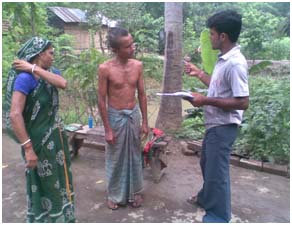Guest post: Veena Khanduri, India Water Partnership
The Gangetic river basin in Eastern India receives heavy monsoon rainfall, much higher than the rest of India. Nonetheless, the region suffers from both the problem of year round water availability as well as poor quality of drinking water. Due to excessive exploitation, the groundwater aquifers in the region have been depleting alarmingly, surface water is highly limited & poorly maintained and consequently cannot count up as a major source of safe drinking water.
Recharge of groundwater is not commensurate with its withdrawal, with the result that the water quality has been deteriorating rapidly. Arsenic contamination has been detected in large parts of the region. Fluoride contamination is found in some areas; salinity and prevalence of iron in drinking water is also widespread. Appropriate technologies must be designed and ways found for their effective implementation in order to cope with the problem.
Although water is the most vital need that sustains life on earth, experts argue that the propensity to give priority to water supply over sanitation, and sanitation over hygiene is one of the key weaknesses behind our failure to improve the level of community health and prevent infectious diseases in the country. A major problem of effective management of water and health security is that large proportions of rural people are still ignorant, indifferent and even ambivalent to the dangers of scarcity and pollution of water.
To assess the exact level of water contamination in Nadia district of West Bengal, India Water Partnership commissioned a brief study to one of its east zone partners - Kalyani Institute for Study, Planning & Action for Rural Change (KINSPARC). KINSPARC conducted a comprehensive base-line survey of a cluster of villages in Nadia, based on which two villages were identified for in-depth study. These villages were ‘Iswaripur’ in ‘Sarati’ Gram Panchayat, and “Chandamari” in “Kanchrapara” Gram Panchayat.
KINSPARC conducted a series of meetings and interactions with villagers in these two Gram Panchayats on problems commonly faced by villagers such as Drinking Water, Sanitation, Health and Livelihoods. While in Iswaripur, KINSPARC organized awareness generation meetings, in Chandamari village, water quality testing and awareness generation meetings were held. There are 104 tube wells in Chandamari village.

A household being interviewed during the baseline survey
Image courtesy: India Water Partnership
Water testing was carried out in all the 104 tube wells of Chandamari village and the test samples were grouped in three categories:
- Safe: Below 50 micro gram/liter: 28 tube wells
- Moderately safe/ Unsafe: Around 50 microgram/liter: 52 tube wells
- Highly unsafe: Above 50 milligram/liter: 24 tube wells
KINSPARC advised the villagers to use water only from the safe tube wells. It prepared a detailed map, which was presented to the villagers in order that they refrain from using unsafe tube wells.
The study, through village experiments, suggests that recognition of a problem must precede search for solutions. Awareness and attitudinal changes have to be generated among people so that they are induced to identify and adopt technologies and lifestyles that enable them to deal with the problem of an impending disaster. A good and action oriented policy is needed where stakeholders including scientists, policy makers and, above all, society as a whole need to be involved to provide good quality of water to the people.
Impact
The change in awareness and anxiety of Chandamari villagers before and after acquiring the knowledge of existing arsenic pollution in the tube well water in the village shows that as result of the awareness of villagers, there has been a virtual reversal in the villagers’ response. Previously, majority of the people in the village were either largely ignorant or indifferent to the problem of existence and the dangers of arsenic pollution. In contrast, at present most of them are highly conscious about the problem, and many of them are anxious about finding solutions to it.
The workshop-cum-interaction meeting, especially with the participation of women who bear the burden of water sourcing for the household, helped generate awareness among the ambivalent villagers many of whom live a dangerous life with regard to the most vital need for safe drinking water.
Hence awareness and attitudinal changes among people generated by India Water Partnership through KINSPARC may be interpreted as a step towards mitigating the threat of an impending disaster.
India Water Partnership (IWP) is a non-profit organization with a goal of promoting Integrated Water Resources Management (IWRM). It is also accredited by the Global Water Partnership (GWP) headquartered at Stockholm, Sweden as GWP Country Water Partnership known as GWP-India. The mission of IWP is to support action of sustainable and integrated development and management of water resources at national, regional river basin/sub-basin and local levels in India through promotion of Integrated Water Resource Management.
Addressing adaptation to climate change with the support of zonal water partners across the country; encouraging use of innovative low cost water saving technologies by the farming communities ; sustainable natural resource management; integrated domestic water management; promoting Area Water Partnership (AWP) for river basin management; conflict resolution on water sharing; inter-state trans-boundary water sharing issues, gender mainstreaming, etc. are some of the core priority areas of IWP.
For further information, please contact:
Dr. Veena Khanduri,
Executive Secretary, India Water Partnership (IWP)
Host Institution - Institute for Human Development (IHD), NIDM Building, IIPA Campus
IP Estate, Mahatma Gandhi Marg, New Delhi 110002. India
Tel: +91-11-23358166, 23321610; Email: iwpneer@gmail.com Web: www.cwp-india.org
/articles/water-sanitation-and-health-situation-select-villages-nadia-district-west-bengal-0